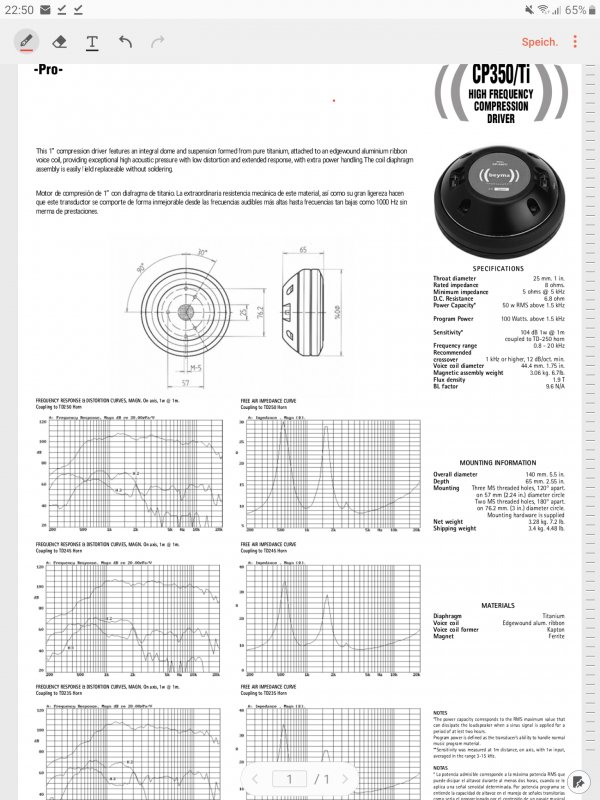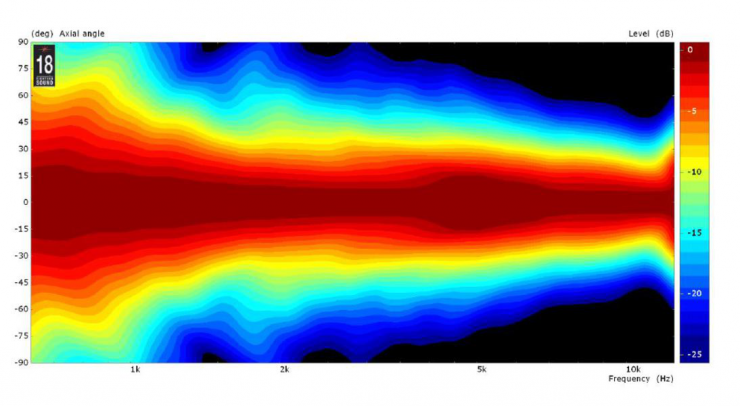I suspect that you are on the right track there , the results should prove interesting.but I think the 18 sound horns are very competently designed and I don’t think it’s profile, which is very sophisticated to avoid resonance but I think the material is kind of thin plastic that probably causes it. I might damp them and see again.
First trials of active horn speaker
- Thread starter morricab
- Start date
You are using an out of date browser. It may not display this or other websites correctly.
You should upgrade or use an alternative browser.
You should upgrade or use an alternative browser.
Nasality can come from the throat. Both horns are same cut off?There was some nasality with the 18 sound horns with some vocals that is totally absent with the wood horns. Is it the wood ? The shape? Hard to say but I think the 18 sound horns are very competently designed and I don’t think it’s profile, which is very sophisticated to avoid resonance but I think the material is kind of thin plastic that probably causes it. I might damp them and see again.
Last edited:
There was some nasality with the 18 sound horns with some vocals that is totally absent with the wood horns. Is it the wood ? The shape? Hard to say but I think the 18 sound horns are very competently designed and I don’t think it’s profile, which is very sophisticated to avoid resonance but I think the material is kind of thin plastic that probably causes it. I might damp them and see again.
Did you take any measurements?? Could also be differences with your crossover points. You went lower could be a peak in the "woofer" hard to say either way unless you know what the response is for each individual driver.
Rob
Last edited:
Super linear, good beam angle 18 soundView attachment 113316
Put the horn in a sand filled wood chamber.
Hello,
Thanks for posting and I’m trying to understand your graph , it appears to me that this is a very “Beamy” graph , is this a good thing ..?
Would this make the speaker sound hot when on axis ..?
Regards
Nasality can come from the throat. Both horns are same cut off?
What causes them to sound shouty ..?
Hello,
Thanks for posting and I’m trying to understand your graph , it appears to me that this is a very “Beamy” graph , is this a good thing ..?
Would this make the speaker sound hot when on axis ..?
Regards
That is just a normalized curve of just the horn. You can throw that out an octave above the crossover and lower. I tells you nothing of what the system look like. That's a tight beam depends on how it's integrated in the system. If you have it flat on axis as you move off you will hear the highs drop off. The overall power response may suffer.
Rob
Typically peaks in the response or the horn a bit to loud overall.What causes them to sound shouty ..?
Rob
Higher order modes from deficient profiles is the classical reason. Nowadays, in most profiles diffraction from the horn mouth is the typical culprit if no major frequency response issues are present. A slight phase mismatch in the crossover region can also be the reason, but it’s typically more noticed as a nasally reproduction.What causes them to sound shouty ..?
Just listing the canonical reasons, nothing pointing this is the case here, don’t see anything jumping out.
Really cool looking project @morricab!
Yes, haven’t given up on it yet because there is a lot to like in the sound. They said the wooden Tractrix is really a good match with the Beyma driver.Super linear, good beam angle 18 soundView attachment 113316
Put the horn in a sand filled wood chamber.
The 18 sound horn uses their computer modelled ellipsoidal profile that was designed to eliminate HOMs and be constant directivity. It has a larger sweet spot than the wooden Tractrix. It also doesn’t have diffraction issues…I just think the material and thickness let it down a bit.Higher order modes from deficient profiles is the classical reason. Nowadays, in most profiles diffraction from the horn mouth is the typical culprit if no major frequency response issues are present. A slight phase mismatch in the crossover region can also be the reason, but it’s typically more noticed as a nasally reproduction.
Just listing the canonical reasons, nothing pointing this is the case here, don’t see anything jumping out.
Really cool looking project @morricab!
The constant directivity means that the beam is not narrowing significantly at the higher frequencies. A non CD horn will narrow much more.Hello,
Thanks for posting and I’m trying to understand your graph , it appears to me that this is a very “Beamy” graph , is this a good thing ..?
Would this make the speaker sound hot when on axis ..?
Regards
I still need to go back to try the Iwata horn with Beyma CP350TI driver. At 800hz it might be a bit too low.
The 18 sound horn uses their computer modelled ellipsoidal profile that was designed to eliminate HOMs and be constant directivity. It has a larger sweet spot than the wooden Tractrix. It also doesn’t have diffraction issues…I just think the material and thickness let it down a bit.
What are the cut offs of both horns
All been discussed previously in the thread.What are the cut offs of both horns
I took a look at the driver. you use set amp for this speaker? then you need to flatten the impedance spike if you want to use it below 2khz. this is done with the help of a suction circuit .without that could lead to problems discoloration or shouty.I still need to go back to try the Iwata horn with Beyma CP350TI driver. At 800hz it might be a bit too low.

If there is a constant load, e.g. 4 ohms, for which the transformer is intended, the frequency response is linear.
The tube always "sees" the same working resistance.
(e.g. with 300b single-ended )
If the load resistance now increases at a certain frequency (e.g. 2kHz), the tube "sees" a lower load and the output voltage increases.
This increases the volume of the range.
A speaker that has greater impedance fluctuations will not always be linear on a tube amp.
P.S maybe that's the problem and not the horn.
This is not the driver on the 18 sound horn. On the 18 sound horn or wooden Tractrix I use the Beyma CP755TI.I took a look at the driver. you use set amp for this speaker? then you need to flatten the impedance spike if you want to use it below 2khz. this is done with the help of a suction circuit .without that could lead to problems discoloration or shouty.View attachment 113319
If there is a constant load, e.g. 4 ohms, for which the transformer is intended, the frequency response is linear.
The tube always "sees" the same working resistance.
(e.g. with 300b single-ended )
If the load resistance now increases at a certain frequency (e.g. 2kHz), the tube "sees" a lower load and the output voltage increases.
This increases the volume of the range.
A speaker that has greater impedance fluctuations will not always be linear on a tube amp.
P.S maybe that's the problem and not the horn.
Similar threads
- Replies
- 3
- Views
- 975
- Replies
- 0
- Views
- 410
- Replies
- 4
- Views
- 823
- Replies
- 5
- Views
- 909
- Replies
- 4
- Views
- 607
| Steve Williams Site Founder | Site Owner | Administrator | Ron Resnick Site Owner | Administrator | Julian (The Fixer) Website Build | Marketing Managersing |














